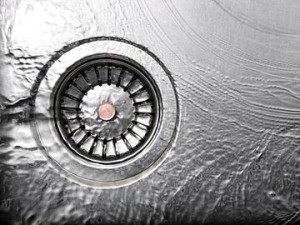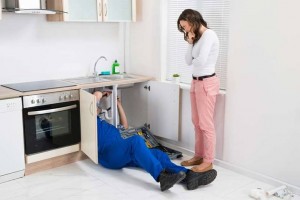5 Tips to Save Your Garbage Disposal!
Garbage Disposal Leaking? Fix the Problem with These Five Expert Tips!
Have you noticed a slow drip beneath your sink? Do you see water pooling around the top of your garbage disposal? Do you suspect something is awry down below? If you suspect your garbage disposal is leaking, there are some quick fixes you can make that will have long-term effects.
You’ll really need to address the problem quickly, as leaking appliances of every kind can lead to mold growth below your sink and in your home. The repercussions to your air quality are intense, and you don’t want to expose the people who live and breath in your home to those conditions. To learn how you can easily and quickly fix your garbage disposal leakage problems and have the peace of mind you need follow our tips provided below.
Do you suspect something is awry down below? If you suspect your garbage disposal is leaking, there are some quick fixes you can make that will have long-term effects. You’ll really need to address the problem quickly, as leaking appliances of every kind can lead to mold growth below your sink and in your home.The repercussions to your air quality are intense, and you don’t want to expose the people who live and breath in your home to those conditions.
To learn how you can easily and quickly fix your garbage disposal leakage problems and have the peace of mind you need follow our tips provided below.
Tip #1: Do a Top-to-Bottom Inspection
 The first step in fixing a leaking garbage disposal is to figure out exactly where the leak is and what part of the garbage disposal is compromised.
The first step in fixing a leaking garbage disposal is to figure out exactly where the leak is and what part of the garbage disposal is compromised.
Many leaks can be fixed very easily and inexpensively without having to do a full replacement of a disposal. Now, the one exception to the replacement rule is if you find that your disposal is leaking from the bottom.
If this is the case, then it’s likely the disposal’s internal sealant and seals have been compromised – and it probably will be cheaper and more efficient to replace the disposal.
The key is to do a thorough enough inspection that you find all the weak points and address them quickly. To that end, do a top-to-bottom inspection with a head lamp and a magnifying glass.
Notice where the water is leaking. For example, if the leak is at the top of the disposal, it could be your seal – known as a flange – has loosened or deteriorated. With this first step, you’re already a pro who not only will be able to diagnose the leak, but you’ll learn a ton about your disposal and be able to troubleshoot the issues in the future.
Tip #2: Reseal, Reseal, Reseal
If you discover that the culprit is a deteriorating seal, then you can fix the problem by re-sealing using some inexpensive plumber’s putty that you can purchase from any home improvement store.
Make sure that you fill in any cracks and gaps, and give the new sealant enough time to dry – according to the putty’s instructions – before allowing any water to interact with the new seal. You certainly don’t want to do all that hard work only to have the sealant wash away or weaken over time because you didn’t give it enough time to set.
Tip #3: Check Your Drain Lines
 You’re about to learn a lot about the anatomy of your garbage disposal — and you’ll be better for knowing it! It’s very common for a garbage disposal to leak at the point where the drain lines come together and connect. Garbage disposals have two connections — one on each side of the appliance.
You’re about to learn a lot about the anatomy of your garbage disposal — and you’ll be better for knowing it! It’s very common for a garbage disposal to leak at the point where the drain lines come together and connect. Garbage disposals have two connections — one on each side of the appliance.
The larger drain line pipe goes to your sewer. The smaller drain line pipe is used by your dishwasher, if you have one, to drain into the disposal. Most of the time, these lines are connected with a metal clamp. Knowing what kinds of components are used to secure the drain lines is key because it will inform what tools you used and what steps you take to try to eliminate the leak at these points.
Tip #4: Tighten Up
Knowing there is a leak at one or more of your drain lines, it’s time to tighten them. You can stop a leak at the drain lines by simply tightening that metal clamp or the screws on the drain lines.
You may find that you also need to completely replace the rubber gasket to get the tightest seal. Over time, these components can loosen and experience wear and tear. In addition, there are some disposals that have flanges that have screws. So you’ll need to get a tighter seal on the sink flange by tightening the screws with a screwdriver.
Tip #5: Look for Cracks
 Finally, inspect the pipes beneath your sink for cracks. If you’re in an old house with old appliances and pipes, then it’s likely that there are going to be some inferior components that should be replaced altogether.
Finally, inspect the pipes beneath your sink for cracks. If you’re in an old house with old appliances and pipes, then it’s likely that there are going to be some inferior components that should be replaced altogether.
Sometimes it’s not the actual garbage disposal that is the problem, but it’s a loose seal or crack on the pipes connected beneath your sink. You may need to seal, tighten or replace one of those parts to address the dripping (hopefully not spewing) water.
After you’ve inspected and repaired the leaks, it’s always good to go back over the entire piping and disposal system with a flashlight to make sure there aren’t cracks or gaps that could become ticking time bombs in your home. Getting ahead of future leaks is key to maintaining a dry, healthy kitchen where a garbage disposal is concerned.
Are you ready to get started on being a handy person in your kitchen? Are you ready to tackle that leaking garbage disposal with confidence and the expert know-how? With just a few small tweaks to your home maintenance schedule, you can fix a leaking garbage disposable on your own and save money by not having to repair additional appliances – or worse, your kitchen cabinets and flooring.
When water is involved, immediate action is required, and you have to take care of it. Our guide shows you how to do it, but if you find that your leaking garbage disposal is out of your league, we’re here to help.
Call the plumbing experts at Jim Wagner Plumbing, Inc., in Lombard, IL at (630) 577-9241. We’re here to help!
